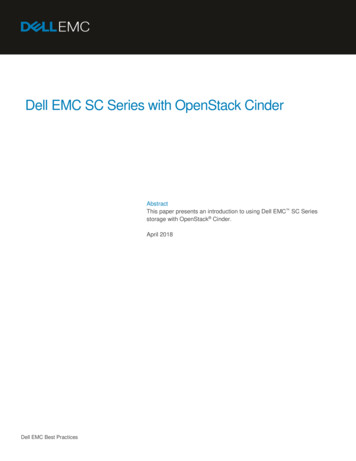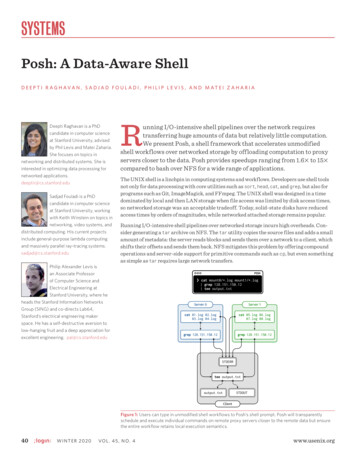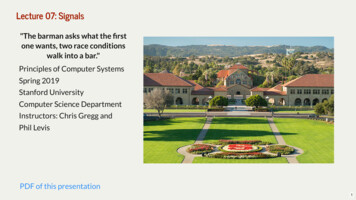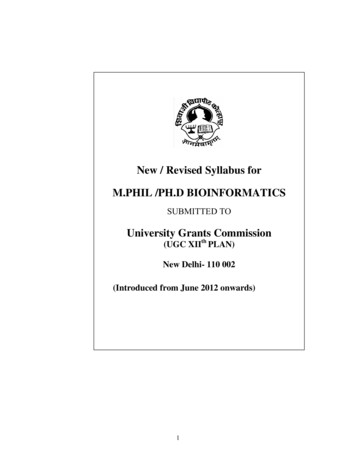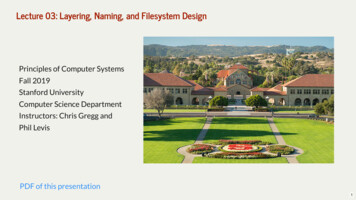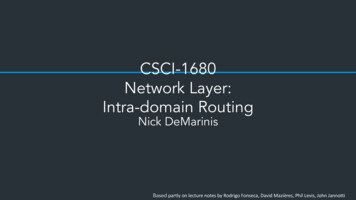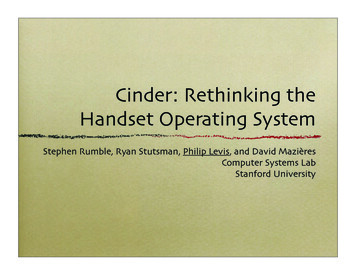
Transcription
Cinder: Rethinking theHandset Operating SystemStephen Rumble, Ryan Stutsman, Philip Levis, and David MazièresComputer Systems LabStanford University
UNIX, a Life
The Progression19712009
POSIX Standardized in 198819881989
Computing has Changed Commodity devices Rich, user-centric applications Battery-powered Untrustworthy programs
The State of the Art Today
Cinder A new operating system designed for mobile phones Goal: be able to download and run any code without worry Security Solve the morass of current approachesTrack data, not codeEnables simple and easy user policiesEnergy Efficiency Allow the OS to energy-limit applicationsAllow programs to see, in detail, where energy is going Start with a clean design, then seek backwards compatibility
Cinder A new operating system designed for mobile phones Goal: be able to download and run any code without worry Security Solve the morass of current approachesTrack data, not codeEnables simple and easy user policiesEnergy Efficiency Allow the OS to energy-limit applicationsAllow programs to see, in detail, where energy is going Start with a clean design, then seek backwards compatibility
Framing the Problem Energy efficiency Energy efficiency trades off with time to completionNever doing something costs no energy Energy accounting Track what is spending it Energy limiting Limit the energy consumption of a particular applicationProtects system lifetime from bad applications
Energy Efficiency
Device Control Primary challenge is knowing the future workload Do you power down a device and later spend the cost for warm-up? Made more difficult by traditional I/O pattern Control returns to application a*er I/O, when it might request againApplicationKernelDevice
Device Control Primary challenge is knowing the future workload Do you power down a device and later spend the cost for warm-up? Made more difficult by traditional I/O pattern Control returns to application a*er I/O, when it might request againApplicationKernelDevice
Device Control Primary challenge is knowing the future workload Do you power down a device and later spend the cost for warm-up? Made more difficult by traditional I/O pattern Control returns to application a*er I/O, when it might request againApplicationKernelDevice
Device Control Primary challenge is knowing the future workload Do you power down a device and later spend the cost for warm-up? Made more difficult by traditional I/O pattern Control returns to application a*er I/O, when it might request againApplicationKernelDevice
Device Control Primary challenge is knowing the future workload Do you power down a device and later spend the cost for warm-up? Made more difficult by traditional I/O pattern Control returns to application a*er I/O, when it might request againApplicationKernelDevice
Device Control Primary challenge is knowing the future workload Do you power down a device and later spend the cost for warm-up? Made more difficult by traditional I/O pattern Control returns to application a*er I/O, when it might request againApplication?Kernel?Device
Asynchrony Asynchronous I/O: breaks 1-to-1 between threads and I/O Key mechanism for high performance/highly parallel servicesMore I/O requests gives OS better scheduling flexibility Asynchronous I/O can improve energy efficiency Given a workload, OS can schedule itOS difficulty is when an energy resource goes idle
Power Locks Every device driver ends up with a specialized policy andmechanism for power management Insight: locks have knowledge of future workload Power locks integrate concurrency and power management When lock falls idle, power down, perhaps delayedPower Lock Power locks simplify device drivers Single, general mechanism SOSP 2007LockPower Control
Energy Accounting(Fonseca, Dutta, Levis and Stoica, OSDI 2008)
A Personal Story
Black Box No way for users or applications to account for energy use “What’s expensive” is a guessing game3 bits of information!
Accounting (for wireless sensors)(OSDI 2008)Metering8MCUBlueGreenRedAggregate Quanto TraceOscilloscope Trace7BreakdownCurrent ( 14
Metering Metering: iCount, using a PFM switching regulator A single wireAlmost zero cost (24 instructions to sample, 1µJ accuracy)
Virtual Metering Suzanne Rivoire (Sonoma State University) and ChristosKozyrakis (Stanford University) Use internal system performance counters Derive a model of energy consumption Accurate to within 2% on most processors Extend to broader system
Breakdown Instrument each energy sink (hardware resource) to trackexplicit power state Log aggregate energy consumed, interval length, and powerstate of all devices Use linear regression to derive the power draw of eachdevice power state
Activity Tracking Track in terms of “resource principals” All uses of hardware resources have an associated principalUse labels to track which principal is activeSimple API to change principal
Activity Tracking Track in terms of “resource principals” All uses of hardware resources have an associated principalUse labels to track which principal is activeSimple API to change principal Account on power state or principal change Share costs across principals when needed!"# %&'(!(* ,4.5(* ,4.6(!"# %&'()(* ,(-./01(2&3&0(* ,(!"# %#07(* ,4.5(* ,4.6(!"!88(!(!# "!88()(90:(!( "90:()(;%:0(
Power Summary Power locks to easily manage device power states Accurate accounting throughmetering, linear regression,and state tracking
Energy Limiting
Story, Revisited
Design Considerations Need to be able to rate-limit energy consumption Control input power rateUntrustworthy programs can use up entire battery Need to allow infrequent burst of high use Build up energy Prevent starvation An idle program should not hoard all unused energy
So*ware Capacitor A capacitor C has an energy input i and a decay rate d C C*d e A capacitor can create sub-capacitors Sum of children inputs must be parent inputThe OS has a “root capacitor,” the battery Programs with an empty capacitor do not run iA lack of energy manifests as poor performance Prevent an app from consuming all the batteryCd
Chaining
Why Decay? Another approach: hard caps A*er capacitor reaches maximum capacity, all input leaks Decay has two advantages Integrates rate with capacity (simpler management)Provides a smoother signal (simpler control systems)CapDecay
Task Profiles Capacitors are a mechanism for enforcement Need system for policy Explicit statement of user intentions “I expect my maps application to last 2 hours”“I expect to be able to watch movies for 4 hours” Capacitors provide direct feedback Limits resource use implicitly (e.g., only gets 20% of CPU)Application adapts its performance accordingly
Malicious Code Emergence of third-party application markets Walled gardens Prevent an application from running down the battery usinga task profile
Information Flow Energy has implications to security Decay rate depends on quantity C Decaying energy is a form of information flowRequires labels/taint Decayed energy returns to the root capacitor As input is constant, there is no information flow until system runs outof energyInputs must therefore be constant: a contract
Steps Port HiStar to ARM processors (almost done) Add capacitors (done) Fit nicely into HiStar’s container hierarchy Run HiStar on Android phones Incorporate energy accounting into HiStar Metering, virtual metering Explore mechanisms Explore policies and user interfaces
Cinder A new operating system designed for mobile phones Goal: be able to download and run any code without worry Security Solve the morass of current approachesTrack data, not codeEnables simple and easy user policiesEnergy Efficiency Allow the OS to energy-limit applicationsAllow programs to see, in detail, where energy is going Start with a clean design, then seek backwards compatibility
Questions and Feedback
Power Locks Every device driver ends up with a specialized policy and mechanism for power management Insight: locks have knowledge of future workload Power locks integrate concurrency and power management When lock falls idle, power down, perhaps delayed Power locks simplify device drivers Single, general mechanism SOSP 2007 Power Lock
